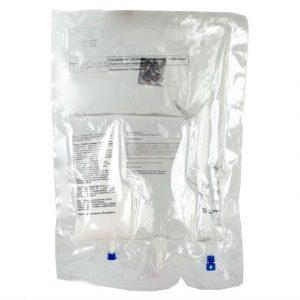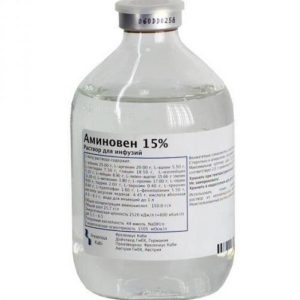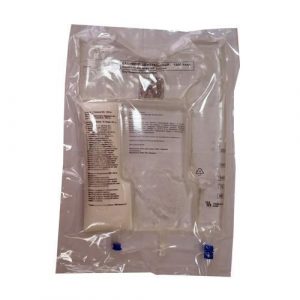Description
Pharmacological action of
Long-chain omega-3 fatty acids are partially incorporated into plasma and tissue lipids. Docosahexaenoic acid is an important component of structural phospholipids of cell membranes, eicosapentaenoic acid is a precursor for the synthesis of eicosanoids: prostaglandins, thromboxanes, leukotrienes and other lipid mediators. The polyunsaturated fatty acids of the omega-3 family affect the biophysical characteristics of cell membranes by changing the composition of phospholipids and cholesterol, which improves the fluidity of the membrane. A concomitant increase in the ability to deform blood cells may be an explanation for the improvement of the rheological properties of blood when consuming fish oil or the introduction of Omegaven. Moreover, omega-3 polyunsaturated fatty acids modify the function of membrane enzyme systems, receptors, and impulse transmission. Omega-3 fatty acids improve the treatment of pathological disorders in premature infants, as well as inflammatory bowel diseases, psoriasis, atopic dermatitis, sepsis, burns, postoperative conditions, and cancer. Omegaven has an immunomodulating, anti-inflammatory effect: it restores the ratio of lipid mediators of inflammation (including prostaglandin, thromboxanes, leukotriene, cytokines).
The most important are the long chain omega-3 fatty acids: eicosapentaenoic acid (C20: 5 -3) and docosahexaenoic acid (C22: 6 -3). The ability of the human body to synthesize eicosapentaenoic and docosahexaenoic acid is very low. Therefore, eicosapentaenoic acid and docosahexaenoic acid must come from the outside naturally with food or intravenously.
The glycerol found in Omegaven is used to generate energy or is re-esterified with free fatty acids in the liver to form triglycerides.
Egg yolk phospholipids are incorporated into cell membranes, being indispensable components to maintain their integrity, or are hydrolyzed.
Pharmacokinetics:
The size of the lipid globules administered with omegaven and the biological properties are identical to those for physiological chylomicrons in the blood. In healthy volunteers, men, the half-life of triglycerides administered intravenously with Omegaven was 54 minutes.
The therapeutic effect of the intravenous route of administration of omega-3 fatty acids is characterized by a rapid onset of action and high efficacy in acute diseases.
Indications
In the complex treatment of inflammatory bowel diseases, sepsis, burns, cachexia (for cancer, cardiological diseases, etc.), and in postoperative conditions with deficiency of omega-3 fatty acids.
parenteral nutrition for adults with the inclusion of omega-3 fatty acids, especially eicosapentaenoic and docosahexaenoic, when oral or enteral nutrition is impossible, insufficient or contraindicated.
Contraindications
Severe hemorrhagic disorders
Certain acute and life-threatening conditions, such as collapse and shock, acute myocardial infarction, stroke, embolism, coma of an unclear genesis
Omegavenin with allergy to fish should not be used in patients.
Children’s age
General contraindications for parenteral nutrition: hypokalemia, hyperhydration, hypotonic dehydration, acidosis.
Caution
Intravenous administration of omegaven may cause prolonged bleeding time and inhibition of platelet aggregation. Therefore, Omegaven should be prescribed with caution to patients in need of anticoagulant therapy, even taking into account the possible reduction in the dose of these drugs.
Omegaven should be prescribed with caution in patients with impaired lipid metabolism and uncontrolled diabetes mellitus.
Due to lack of experience, Omegaven should not be prescribed in patients with severe hepatic or severe renal failure.
Pregnancy and lactation
Omegaven should not be used during pregnancy and lactation, as there is insufficient evidence to support its safety in these conditions.
Special instructions
Recommended daily monitoring of serum triglyceride concentrations. Serum triglycerides during infusion of the fat emulsion should not exceed 3 mmol / L. The following should be regularly monitored: blood glucose level, acid-base state, water-electrolyte balance, blood test and bleeding time in patients receiving anticoagulant treatment.
Composition of
1 liter of emulsion contains:
Active ingredients:
Highly purified fish oil, containing: 100 g sbent2,2p
docosahexaenoic acid 14.4-30.9 g
myristic acid 1.0 – 6.0 g
palmitic acid 2.5-10.0 g
palmitoleic acid 3.0 – 9.0 g
stearic acid 0.5 – 2.0 g
oleic acid 6.0-13.0 g
linoleic acid 1.0 – 7.0 g
linolenic acid less than 2.0 g
octadecatetraenoic acid and 0.5 – 6.54 g
eykozaenovaya acid 0.5 – 3.0 g arachidonic acid
1.0 – 4.0 g
dokozaenovaya acid is less than 1, 5 g
docosapentaenoic acid 1.5 – 4.5 g
d, l – tocopherol 0.150-0.296 g
Other ingredients:
egg yolk phospholipids 12.0 g
glycerol 25.0 g
sodium oleate 0.3 g
sodium hydroxide (for pH adjustment) qs
water for injection up to 1 l
Energy value 4700 kJ / l = 1120 kcal / l
Osmolality 342 ± 10% mOsm / kg 2O
Titratable acidity <1 mmol ¡l / l 7rd 5 – 8.7 Dosage and Administration For infusion into a central or peripheral vein. The bottle should be shaken before use. When Omegaven is prescribed / used with other infusion media (e.g. amino acid solutions, carbohydrates) through a conventional intravenous infusion system, the compatibility of the solutions and emulsions used must be guaranteed. Daily dose: 1-2 ml of Omegaven per 1 kg of body weight per day = 0.1-0.2 g of fish oil per 1 kg of body weight. This is approximately equal to 70-140 ml of Omegaven for a patient weighing 70 kg. Maximum daily dose: 2 ml / kg / day Maximum infusion rate: The infusion rate should not exceed 0.5 ml / kg / hour, which corresponds to 0.05 g of fish oil per 1 kg of body weight per hour. You must not exceed the maximum infusion rate, otherwise, a significant increase in serum triglycerides may be observed. Omegaven can be prescribed simultaneously with other fat emulsions. Based on the recommended total daily fat intake of 1 ² 2 g / kg body weight, the proportion of fish oil administered with Omegaven should be 10 ² 20% of this intake. Side effects of Intravenous administration of omegaven can lead to an increase in bleeding time and inhibition (slowdown) of platelet aggregation. In rare cases, patients may have a fishy taste in their mouths. Side effects observed during the infusion of any fat emulsions: Slight fever, fever and / or cold, chills, hyperemia or cyanosis, anorexia, nausea, vomiting, shortness of breath, headache chest pain, back, lower back, ossalgia priapism (in very rare cases), an increase or decrease in blood pressure, anaphylactic reactions (e.g., erythema). Possible signs of metabolic overload should be monitored. The reason may be genetic (individual characteristics and metabolic disorders) or lipid metabolism may be affected by various previous diseases characterized by a varying rate of lipid metabolism, but this condition is mainly observed when using emulsions based on cottonseed oil. Metabolic overload can be manifested by the following symptoms: hepatomegaly with or without jaundice, a change or decrease in some parameters of blood coagulation (for example, bleeding time, clotting time, prothrombin time, platelet count), splenomegaly, anemia, leukopenia, thrombocytopenia, bleeding or bleeding , changes in functional liver function tests, fever, hyperlipidemia, headache, stomach pain, fatigue, hyperglycemia. As soon as these side effects occur or the triglyceride level during the infusion exceeds 3 mmol / L, the administration of any fat emulsion should be discontinued or, if necessary, continue at a lower rate of administration of the drug. Drug Interactions Intravenous administration of omegaven may cause prolonged bleeding time and inhibition of platelet aggregation. Therefore, Omegaven should be prescribed with caution to patients in need of anticoagulant therapy, even taking into account the possible reduction in the dose of these drugs. Omegaven can only be mixed with preparations of fat-soluble vitamins (Vitalipid) and water-soluble vitamins (Soluvit) and other fat emulsions (Intralipid, Lipovenosis, etc.). Incompatibility: Incompatibility may occur when polyvalent cations (e.g. calcium) are added, especially in combination with heparin. Storage conditions Store at a temperature not exceeding 25 ° C. Do not freeze! Keep out of the reach of children! Expiration 1,5 years. Do not use after the expiration date. Deystvuyuschee substances Zhyrov e Ñmulsyy parenteral POWER Terms and conditions without prescription dosage form emulsion for infusion




